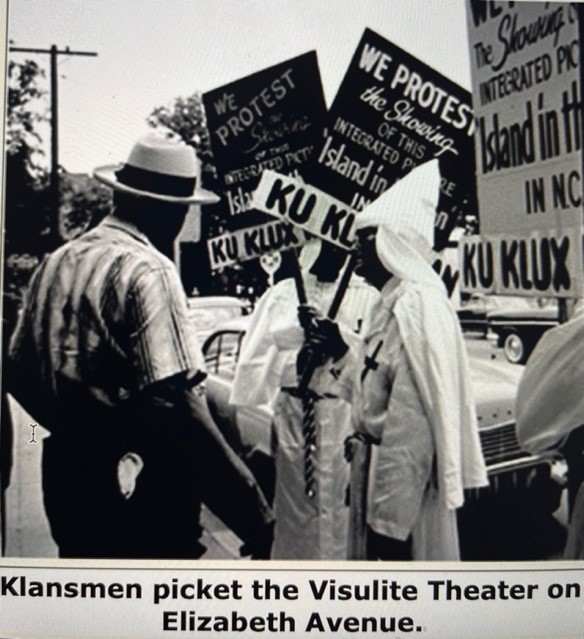By Amy Lefkof
Singer, actor and civil rights activist Harry Belafonte, who died on April 25, 2023 at the age of 96, broke racial barriers in the 1950s. One of those barriers was his performance in Island in the Sun, a movie about race relations and interracial romance. As The Guardian wrote on the evening of Belafonte’s death, there was enough of a “sexual suggestion” surrounding the relationship between Belafonte’s character, a young black union leader, and an elite white woman played by actress Joan Fontaine to have the film “pulled from most movie theaters in the US south.” Most — but not the Visulite Theater in Charlotte.
Despite hooded Klansmen protests, on September 1, 1957, the Visulite on Elizabeth Avenue showed Island in the Sun. The Visulite was then owned by Robert Schrader, Temple Beth El’s first bar mitzvah boy, and his father Jay Schrader, a motion picture salesman and Charlotte Branch Manager of United Artist Movies, who also served as the first president of the Charlotte Federation of Jewish Charities in 1939.
Retired UNC Charlotte History Professor Dr. Dan L. Morrill described the milieu of interracial friction that existed in Charlotte and throughout the south at that time in a chapter entitled, The Emergence of Diversity: African Americans in his A History of Charlotte and Mecklenburg County. Morrill sets forth what happened in Arkansas the day after the movie showed in Charlotte: Governor Orval Faubus surrounded Little Rock’s Central High School with National Guardsmen, declaring that night that if African American students attempted to enter Central High, “blood would run in the streets.” And three days after the Visulite showed Island in the Sun, Charlotte Mecklenburg schools were scheduled to have four African-American students attend previously all-white classrooms for the first time.
With granular detail Morrill chronicles the picketing outside the Visulite: “Klansmen dispersed without incident when they were ordered to do so by Police Chief Frank Littlejohn. ‘A few obvious sympathizers of the Klan parked near the theater jeered photographers who arrived to make pictures of the pickets,’ reported the Charlotte Observer.”
In the early 1960s, the Visulite, quite accidently, went on to become the first integrated movie theater in Charlotte, which led to the integration of all movie theaters in Charlotte six months later. In an April 22, 1990 interview of Robert Schrader, now part of the Archives of the Charlotte Jewish Community stored in the UNCC archives, Schrader describes the Visulite Theater as an “artsy” theater that showed a lot of foreign films with subtitles. One such film was about Rome. He made a deal with some Catholic lay people for them to bring their Sunday School students to the theater for a private showing.
However, prior to the showing, the head of the Catholic Church alerted Schrader to a potential problem: “We have six black children who are members of our Sunday School who I want to send over. But I know it’s against the law, and I don’t want to get you into trouble.”
Schrader dismissed any concerns his Catholic friend had, reasoning that it was a private showing, closed to the public. As Schrader recalls in the taped interview, “That afternoon 400 children from the Sunday School came into the theater to see the movie about the holy city of Rome. Six of them were black children between the ages of 6 and 10. After the movie was over they left the theater, got into their buses and went home.”
That night when Schrader was sitting in the box office the telephone rang. An irate caller asked, “Are you selling tickets to n______ now?” The next day Schrader carried his ads down to the Charlotte Observer and The News, which he did every week in those days. At both papers he was called up to the editor’s office and asked whether he had integrated his movie theater since both papers had received anonymous tips to that effect.
What happened next, recalled Schrader, was that the City of Charlotte called all the movie theater owners in town to a big meeting, along with the NAACP. They agreed on a plan to allow one black person to come into each of the white movie theaters one week, and then the next week two black people would be allowed into each theater, and this would continue over a period of six weeks so that, according to Schrader, “we wouldn’t shock the sensibilities of the Southerners down here.” As Schrader recalled, “pretty soon everything was fine; but it was a very unusual time to live in.”
Amy Lefkof is a freelance writer who wrote the history of Temple Beth El for its 70th Anniversary in 2013.
Photo Caption: Photo of Klan protesters taken outside the Visulite Theater at the showing of Island in the Sun. From Dan Morrill’s A History of Charlotte and Mecklenburg County.


